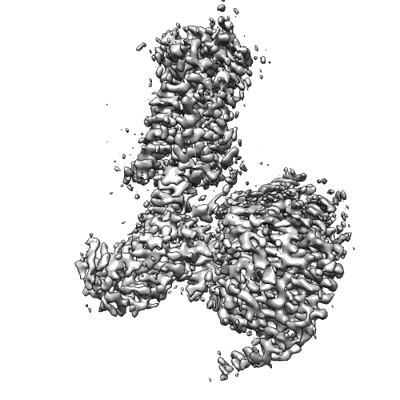EMD-44642
Cholecystokinin 1 receptor (CCK1R) Y140A mutant, Gq chimera (mGsqi) complex
EMD-44642
Single-particle2.59 Å
 Deposition: 29/04/2024
Deposition: 29/04/2024Map released: 22/05/2024
Last modified: 14/08/2024
Sample Organism:
Homo sapiens
Sample: Complex of CCK1R (Y140A mutant) bound to miniGs (Gq, Gi chimera), G-beta1, G-gamma-2 and CCK8s.
Fitted models: 9bkj
Deposition Authors: Cary BP ,
Harikumar KG
,
Harikumar KG  ,
Zhao P
,
Zhao P  ,
Desai AJ
,
Desai AJ  ,
Mobbs JM,
Toufaily C
,
Mobbs JM,
Toufaily C  ,
Furness SGB
,
Furness SGB  ,
Christopoulos A
,
Christopoulos A  ,
Belousoff MJ
,
Belousoff MJ  ,
Wootten D
,
Wootten D  ,
Sexton PM
,
Sexton PM  ,
Miller LJ
,
Miller LJ 
Sample: Complex of CCK1R (Y140A mutant) bound to miniGs (Gq, Gi chimera), G-beta1, G-gamma-2 and CCK8s.
Fitted models: 9bkj
Deposition Authors: Cary BP
 ,
Harikumar KG
,
Harikumar KG  ,
Zhao P
,
Zhao P  ,
Desai AJ
,
Desai AJ  ,
Mobbs JM,
Toufaily C
,
Mobbs JM,
Toufaily C  ,
Furness SGB
,
Furness SGB  ,
Christopoulos A
,
Christopoulos A  ,
Belousoff MJ
,
Belousoff MJ  ,
Wootten D
,
Wootten D  ,
Sexton PM
,
Sexton PM  ,
Miller LJ
,
Miller LJ 
Cholesterol-dependent dynamic changes in the conformation of the type 1 cholecystokinin receptor affect ligand binding and G protein coupling.
Harikumar KG  ,
Zhao P
,
Zhao P  ,
Cary BP
,
Cary BP  ,
Xu X
,
Xu X  ,
Desai AJ
,
Desai AJ  ,
Dong M,
Mobbs JI
,
Dong M,
Mobbs JI  ,
Toufaily C
,
Toufaily C  ,
Furness SGB
,
Furness SGB  ,
Christopoulos A
,
Christopoulos A  ,
Belousoff MJ
,
Belousoff MJ  ,
Wootten D
,
Wootten D  ,
Sexton PM
,
Sexton PM  ,
Miller LJ
,
Miller LJ 
(2024) PLoS Biol , 22 , e3002673 - e3002673
 ,
Zhao P
,
Zhao P  ,
Cary BP
,
Cary BP  ,
Xu X
,
Xu X  ,
Desai AJ
,
Desai AJ  ,
Dong M,
Mobbs JI
,
Dong M,
Mobbs JI  ,
Toufaily C
,
Toufaily C  ,
Furness SGB
,
Furness SGB  ,
Christopoulos A
,
Christopoulos A  ,
Belousoff MJ
,
Belousoff MJ  ,
Wootten D
,
Wootten D  ,
Sexton PM
,
Sexton PM  ,
Miller LJ
,
Miller LJ 
(2024) PLoS Biol , 22 , e3002673 - e3002673
Abstract:
Development of optimal therapeutics for disease states that can be associated with increased membrane cholesterol requires better molecular understanding of lipid modulation of the drug target. Type 1 cholecystokinin receptor (CCK1R) agonist actions are affected by increased membrane cholesterol, enhancing ligand binding and reducing calcium signaling, while agonist actions of the closely related CCK2R are not. In this work, we identified a set of chimeric human CCK1R/CCK2R mutations that exchange the cholesterol sensitivity of these 2 receptors, providing powerful tools when expressed in CHO and HEK-293 model cell lines to explore mechanisms. Static, low energy, high-resolution structures of the mutant CCK1R constructs, stabilized in complex with G protein, were not substantially different, suggesting that alterations to receptor dynamics were key to altered function. We reveal that cholesterol-dependent dynamic changes in the conformation of the helical bundle of CCK receptors affects both ligand binding at the extracellular surface and G protein coupling at the cytosolic surface, as well as their interrelationships involved in stimulus-response coupling. This provides an ideal setting for potential allosteric modulators to correct the negative impact of membrane cholesterol on CCK1R.
Development of optimal therapeutics for disease states that can be associated with increased membrane cholesterol requires better molecular understanding of lipid modulation of the drug target. Type 1 cholecystokinin receptor (CCK1R) agonist actions are affected by increased membrane cholesterol, enhancing ligand binding and reducing calcium signaling, while agonist actions of the closely related CCK2R are not. In this work, we identified a set of chimeric human CCK1R/CCK2R mutations that exchange the cholesterol sensitivity of these 2 receptors, providing powerful tools when expressed in CHO and HEK-293 model cell lines to explore mechanisms. Static, low energy, high-resolution structures of the mutant CCK1R constructs, stabilized in complex with G protein, were not substantially different, suggesting that alterations to receptor dynamics were key to altered function. We reveal that cholesterol-dependent dynamic changes in the conformation of the helical bundle of CCK receptors affects both ligand binding at the extracellular surface and G protein coupling at the cytosolic surface, as well as their interrelationships involved in stimulus-response coupling. This provides an ideal setting for potential allosteric modulators to correct the negative impact of membrane cholesterol on CCK1R.
